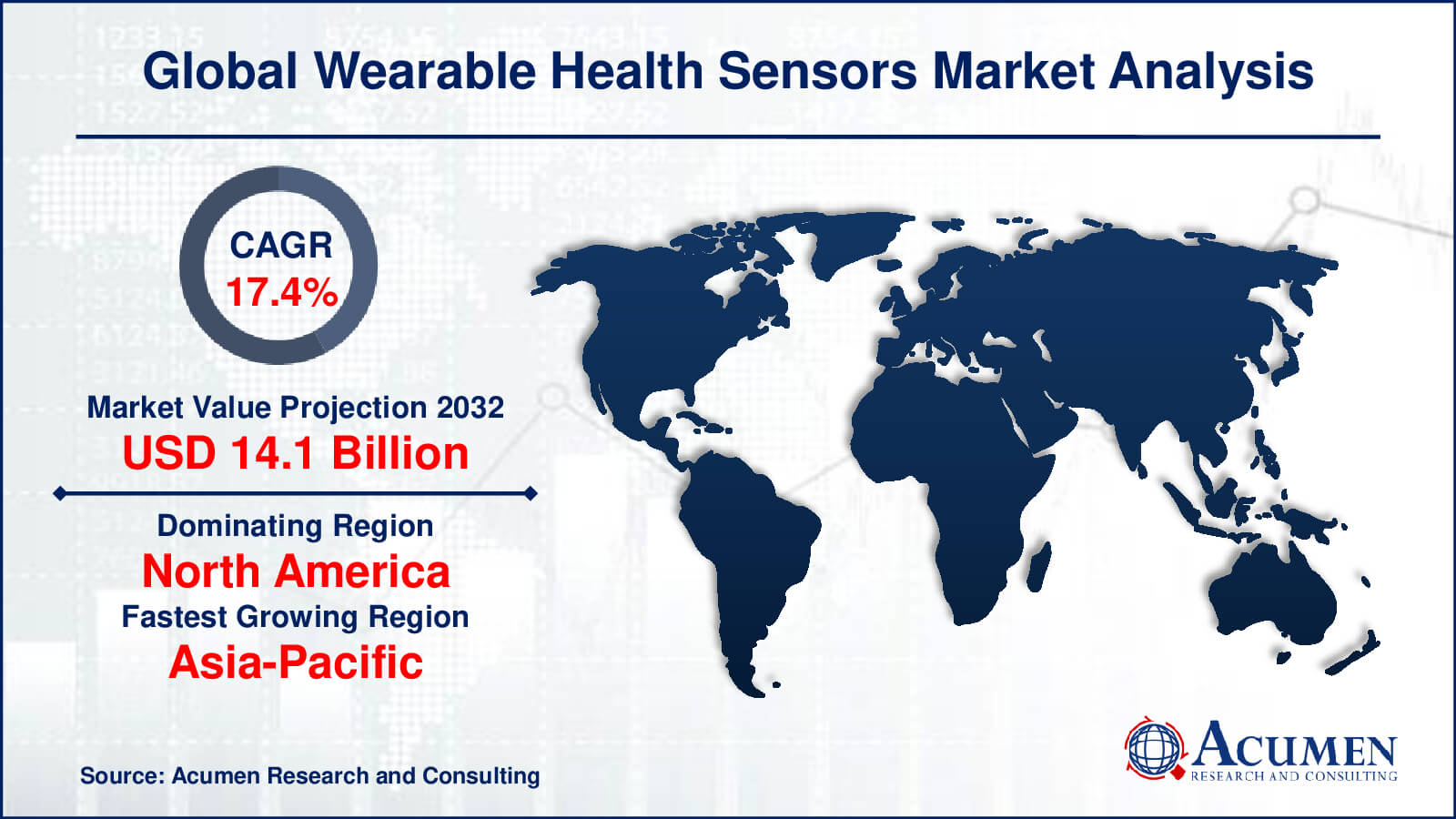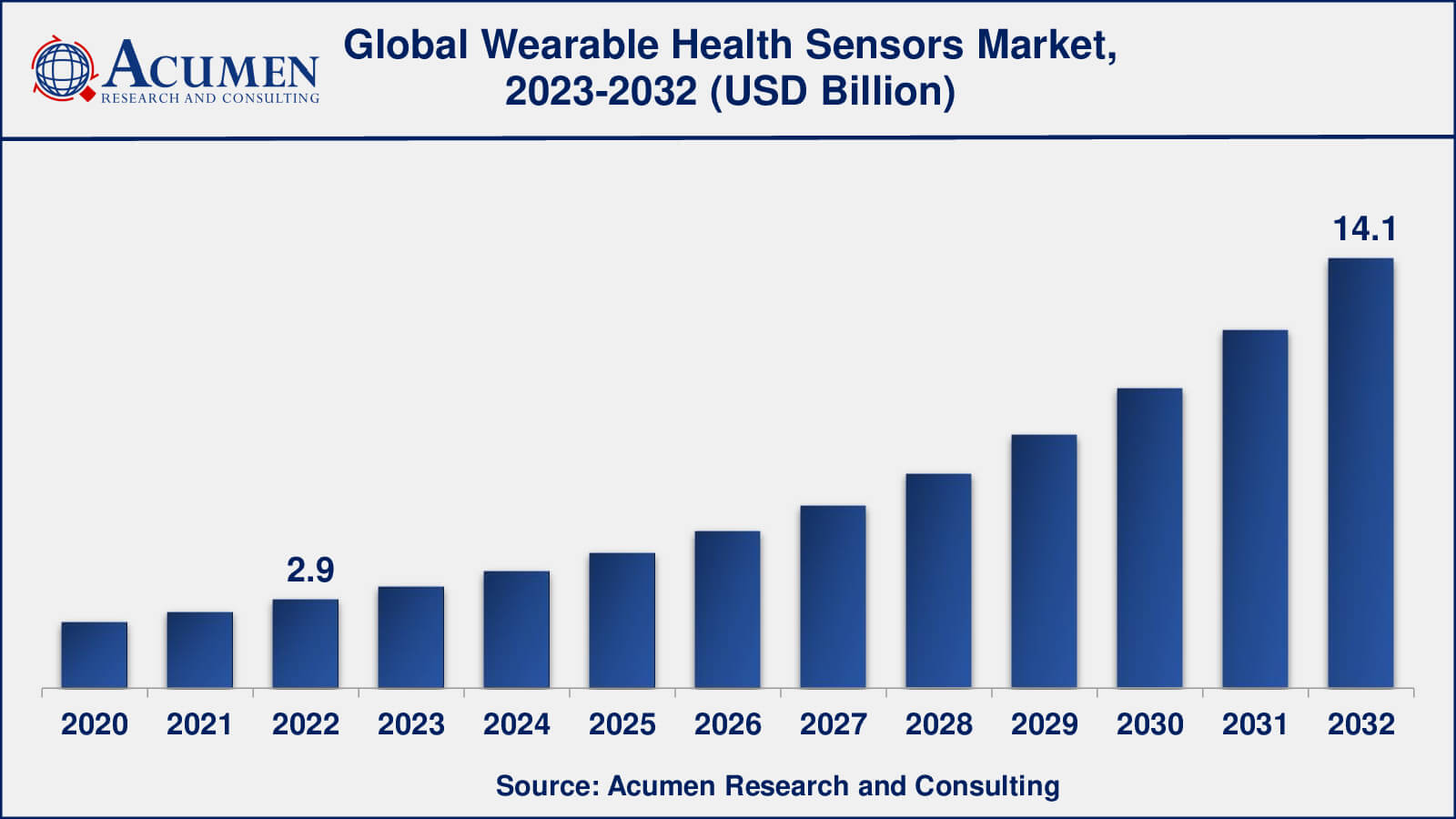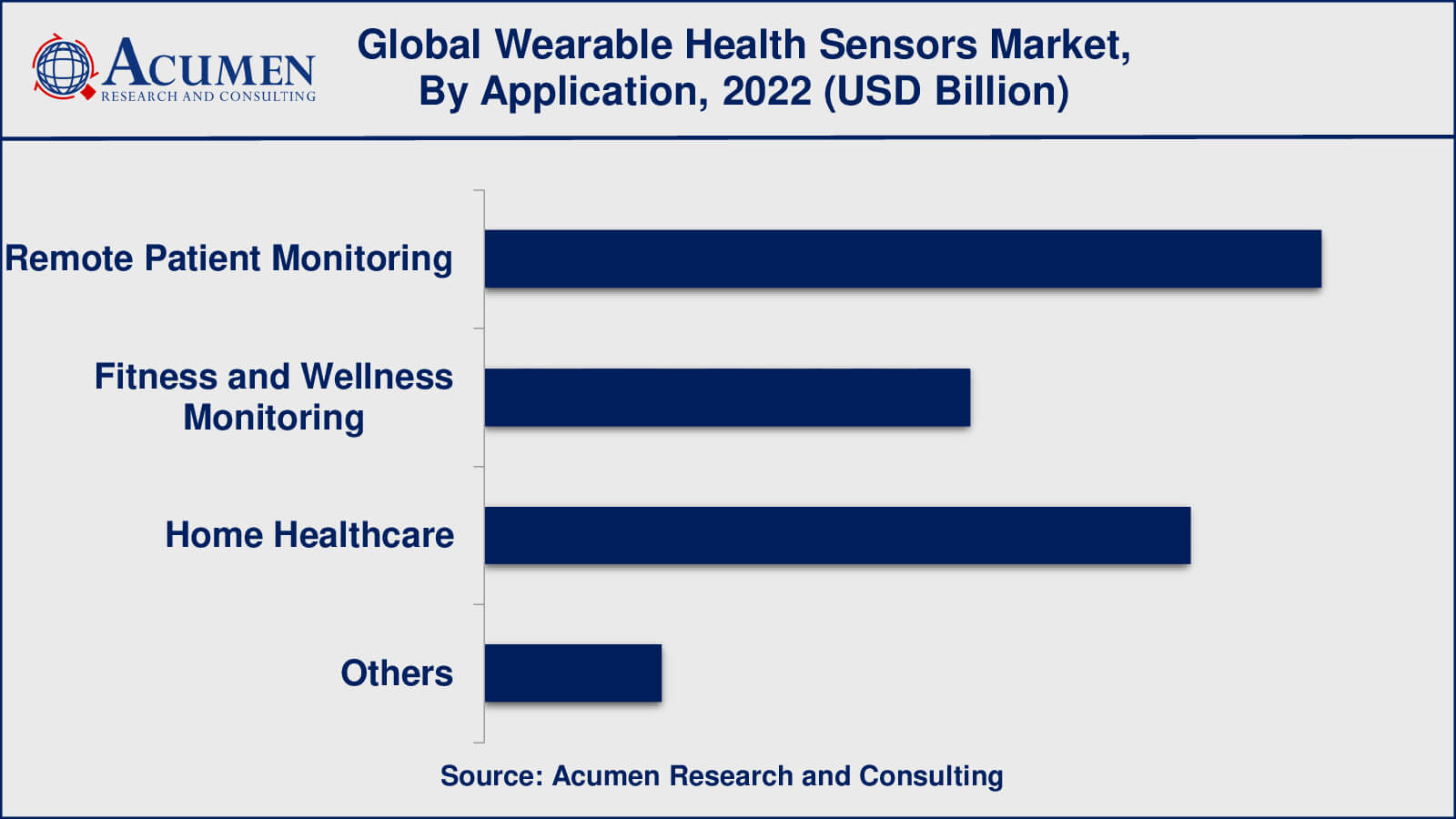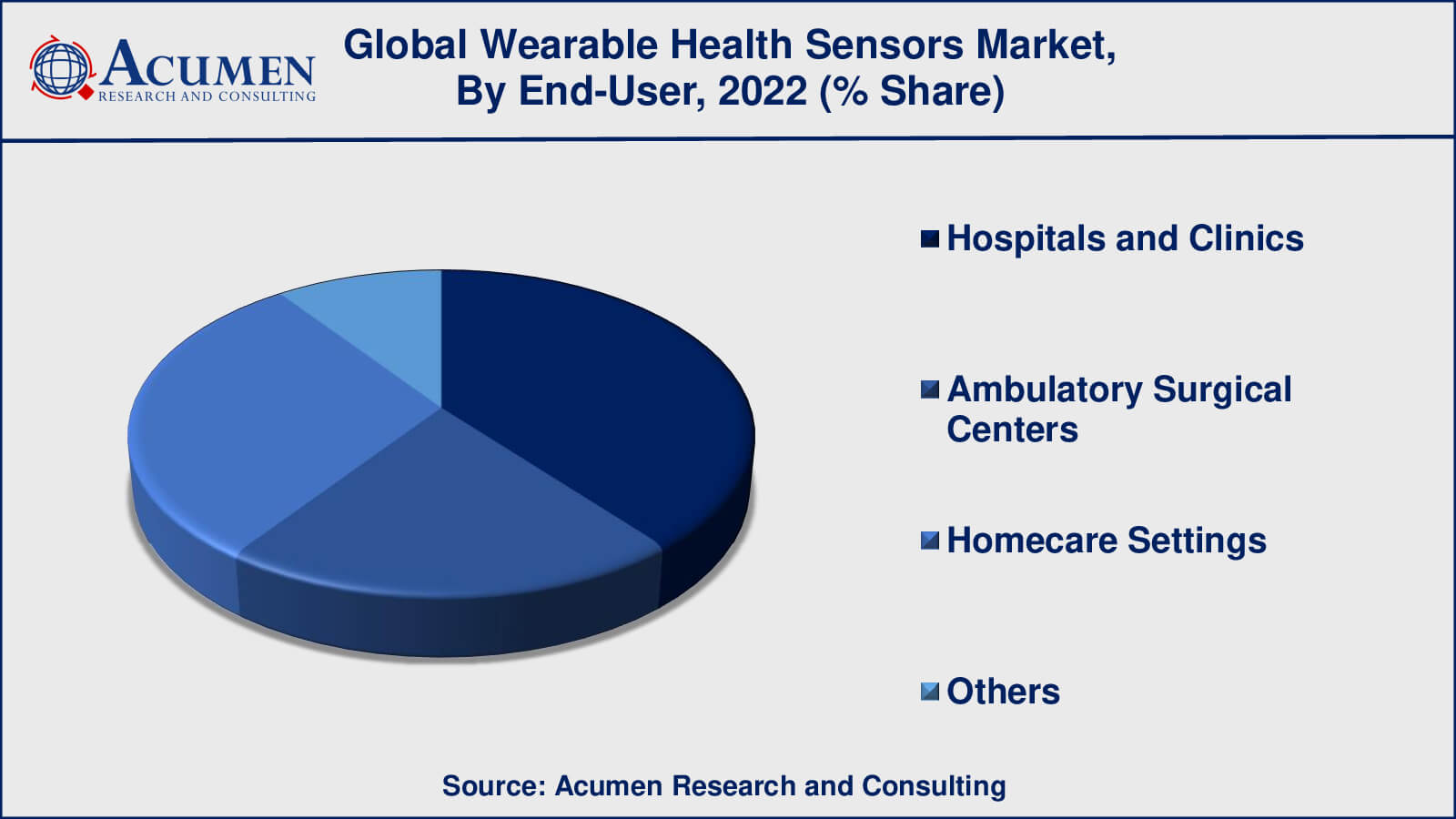April 2024
Wearable Health Sensors Market Size accounted for USD 2.9 Billion in 2022 and is estimated to achieve a market size of USD 14.1 Billion by 2032 growing at a CAGR of 17.4% from 2023 to 2032.
The Global Wearable Health Sensors Market Size accounted for USD 2.9 Billion in 2022 and is estimated to achieve a market size of USD 14.1 Billion by 2032 growing at a CAGR of 17.4% from 2023 to 2032.
Wearable Health Sensors Market Highlights

Wearable health sensors are electronic devices that are worn on the body and collect data on physical activity, sleep patterns, and other health-related parameters. These sensors collect data using a variety of technologies, such as accelerometers, gyroscopes, heart rate monitors, and temperature sensors, and can be used to track health and fitness metrics. Wearable health sensors are gaining popularity among consumers because they provide real-time feedback on health parameters and allow people to monitor their health and wellness. They are also used in clinical settings for remote patient monitoring, allowing healthcare providers to monitor patients' health and intervene as needed.
Wearable health sensors can take the form of smartwatches, fitness trackers, and clothing embedded with sensors. They typically transmit data to a mobile device or a remote server for analysis using Bluetooth or other wireless technologies. Some sensors also use machine learning algorithms to provide users with personalized insights and recommendations. Wearable health sensor data can be used to improve healthcare outcomes, allow early disease detection, and lower healthcare costs. Wearable health sensors can also be used to monitor physical activity and encourage people to live healthier lives.

Global Wearable Health Sensors Market Dynamics
Market Drivers
Market Restraints
Market Opportunities
Wearable Health Sensors Market Report Coverage
| Market | Wearable Health Sensors Market |
| Wearable Health Sensors Market Size 2022 | USD 2.9 Billion |
| Wearable Health Sensors Market Forecast 2032 | USD 14.1 Billion |
| Wearable Health Sensors Market CAGR During 2023 - 2032 | 17.4% |
| Wearable Health Sensors Market Analysis Period | 2020 - 2032 |
| Wearable Health Sensors Market Base Year | 2022 |
| Wearable Health Sensors Market Forecast Data | 2023 - 2032 |
| Segments Covered | By Technology, By Application, By End-User, And By Geography |
| Regional Scope | North America, Europe, Asia Pacific, Latin America, and Middle East & Africa |
| Key Companies Profiled | Apple Inc., Fitbit Inc., Samsung Optical Sensors Co. Ltd., Garmin Ltd., Huawei Technologies Co. Ltd., Xiaomi Corporation, Philips Healthcare, Omron Corporation, Medtronic plc, and Abbott Laboratories. |
| Report Coverage |
Market Trends, Drivers, Restraints, Competitive Analysis, Player Profiling, Covid-19 Analysis, Regulation Analysis |
Wearable Health Sensors Market Insights
The rising prevalence of chronic diseases such as diabetes, cardiovascular disease, and respiratory disorders is one of the primary drivers of wearable sensors market growth. Wearable health sensors can assist in monitoring these conditions by providing patients with real-time feedback on their health status and allowing healthcare providers to intervene as needed. The growing demand for remote patient monitoring is another factor driving market growth. Wearable health sensors can allow patients to monitor their health status from the comfort of their own homes, reducing the need for hospital visits and allowing healthcare providers to deliver care more efficiently. This is especially important in today's healthcare environment, where the COVID-19 pandemic has highlighted the value of remote patient monitoring and telemedicine.
Wearable technology's rise in the healthcare industry is also propelling market growth. Wearable sensors are an appealing option for individuals looking to improve their health and wellness because they provide a convenient and non-invasive way to monitor health parameters and track physical activity. Wearable health sensors can now provide personalized insights and recommendations to users thanks to the integration of AI and ML algorithms, which is driving their adoption even further. Finally, increased R&D investments are driving innovation in the wearable health sensor market, resulting in the development of more advanced and accurate sensors. As a result, demand for wearable health sensors is expected to rise in the coming years.
While the market for wearable health sensors is expanding rapidly, there are several key restraints that may impede its expansion. The high cost of wearable health sensors is one of the major challenges, which may limit their adoption among consumers and healthcare providers. Some sensors are prohibitively expensive, especially for people living in low- and middle-income countries. Concerns about data privacy and security are another major issue. Wearable health sensors collect sensitive health-related data, which must be safeguarded to avoid data breaches and protect patient privacy. Healthcare providers and wearable health sensor manufacturers must take steps to protect and secure data while also informing users about how their data is being used.
Wearable Health Sensors Market Segmentation
The worldwide market for wearable health sensors is split based on technology, application, end-user, and geography.
Wearable Health Sensors Technologies
As per the wearable health sensors market forecast, optical sensors have emerged as one of the market leaders. Light is used by these sensors to measure a variety of health metrics, including heart rate, blood flow, and oxygen saturation. They're common in smartwatches and fitness trackers, and they're getting more accurate and dependable.
Other popular sensor technologies in the wearable health sensors market, in addition to optical sensors, include motion sensors and accelerometers, which are commonly used to track physical activity and movement patterns, and temperature sensors, which can be used to monitor fever or changes in body temperature caused by exercise or other factors. Electrocardiogram (ECG) and electroencephalography (EEG) sensors are also gaining popularity, especially in medical-grade wearables, because they can monitor heart and brain activity, respectively.
Wearable Health Sensors Applications

Remote patient monitoring is the dominant application in the wearable health sensors industry in terms of market share. Wearable devices are used to remotely monitor patients, allowing healthcare providers to track patients' health metrics and intervene quickly if necessary. This application is especially important in today's healthcare landscape because it enables patients to receive high-quality care from the comfort of their own homes, lowering the burden on healthcare systems while improving patient outcomes.
Fitness and wellness monitoring is another important application for wearable health sensors, as these devices can track physical activity, sleep patterns, and other health metrics. These devices, which are commonly found in fitness trackers and smartwatches, are popular among consumers who are interested in tracking their health and fitness. Furthermore, home healthcare is an important application in the wearable health sensor industry, especially for the elderly and disabled, who require regular monitoring and care. Wearable health sensors can be used to detect falls, track vital signs, and monitor medication adherence, among other things, assisting in the delivery of high-quality care to patients at home.
Wearable Health Sensors End-Users

Hospitals and clinics are the industry's dominant end-user segment for wearable health sensors. In hospitals and clinics, wearable health sensors are used for a variety of applications, including remote patient monitoring, post-surgery monitoring, and disease management. These sensors are especially important for patients with chronic diseases because they enable healthcare providers to monitor patients' health metrics and intervene swiftly when necessary, improving patient outcomes and lowering healthcare costs.
Homecare settings, on the other hand, are expected to grow at the fastest rate during the forecasted period of 2023 to 2032. Homecare settings are also an important end-user segment in the wearable health sensor industry, especially for the elderly and disabled, who require regular monitoring and care. Wearable health sensors can help to ensure that patients receive high-quality care at home by monitoring vital signs, detecting falls, and monitoring medication adherence, among other things.
Wearable Health Sensors Market Regional Outlook
North America
Europe
Asia-Pacific
Latin America
The Middle East & Africa
Wearable Health Sensors Market Regional Analysis
Currently, North America is the largest market for wearable health sensors because there are many major players there, the government is supportive, and the region has high healthcare spending. A large number of chronic disease patients live in the region, and they are increasingly using wearable health sensors to monitor their health as well as improve their quality of life.
As a result of the presence of numerous major players and the growing use of wearable health sensors in healthcare settings, Europe is the second-largest market for these sensors. The region also has a large population of elderly people, who are increasingly using wearable health sensors to monitor their wellness and minimize their likelihood of complications.
The Asia-Pacific region is projected to see significant growth in the wearable health sensors market over the next few years, owing to rising healthcare expenditures, an increase in the prevalence of chronic diseases, and an increase in the adoption of technology in healthcare settings. A large number of young people live in the region, and they are increasingly using wearable health sensors to track their health and physical activity.
Wearable Health Sensors Market Players
Some of the top wearable health sensors companies offered in the professional report includes Apple Inc., Fitbit Inc., Samsung Optical Sensors Co. Ltd., Garmin Ltd., Huawei Technologies Co. Ltd., Xiaomi Corporation, Philips Healthcare, Omron Corporation, Medtronic plc, and Abbott Laboratories.
Looking for discounts, bulk pricing, or custom solutions? Contact us today at sales@acumenresearchandconsulting.com
April 2024
July 2024
January 2024
February 2025